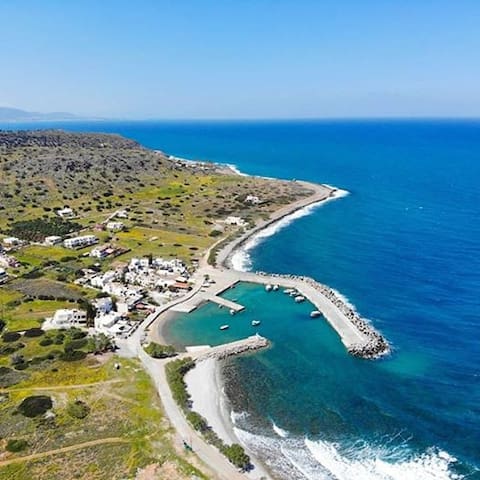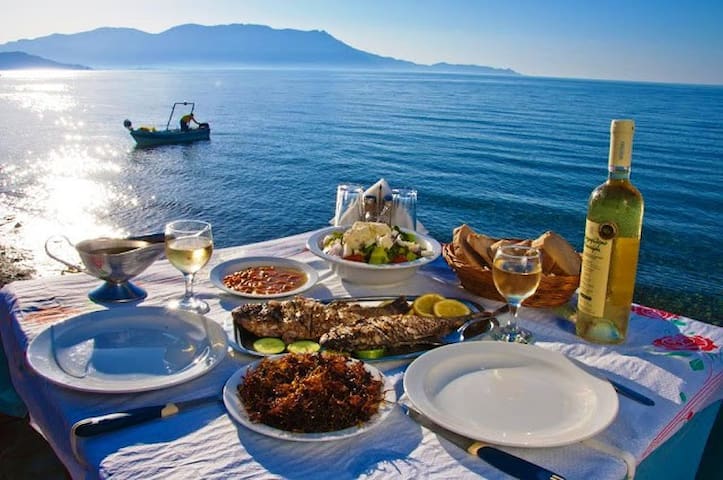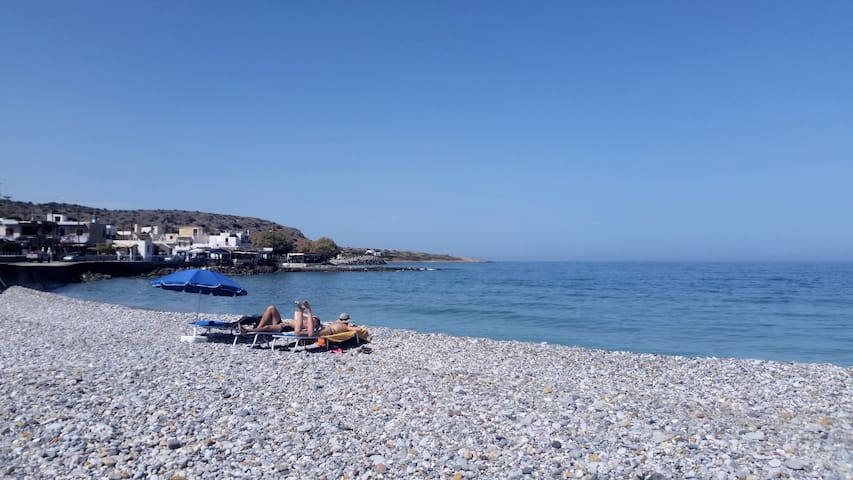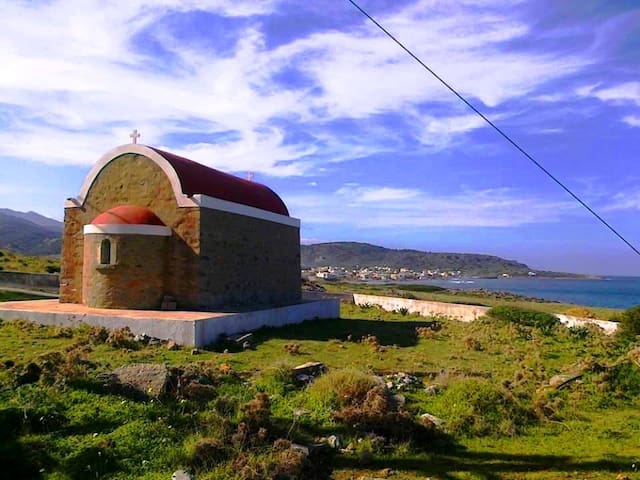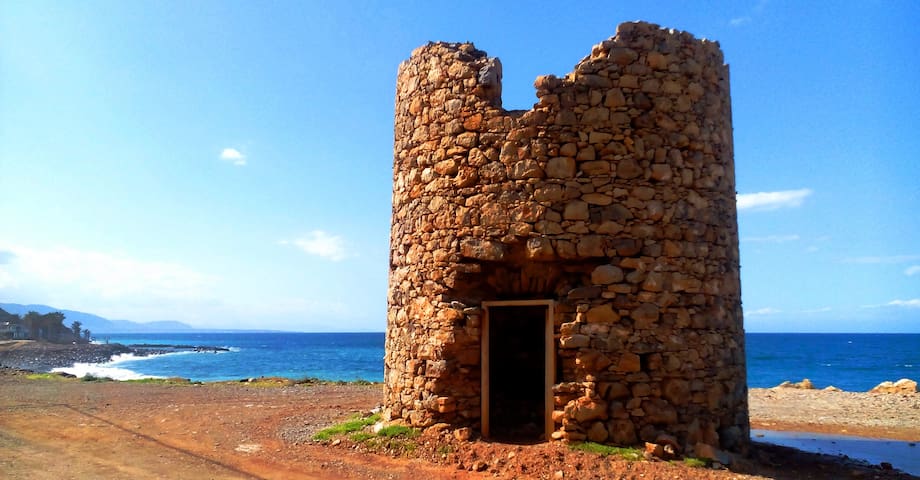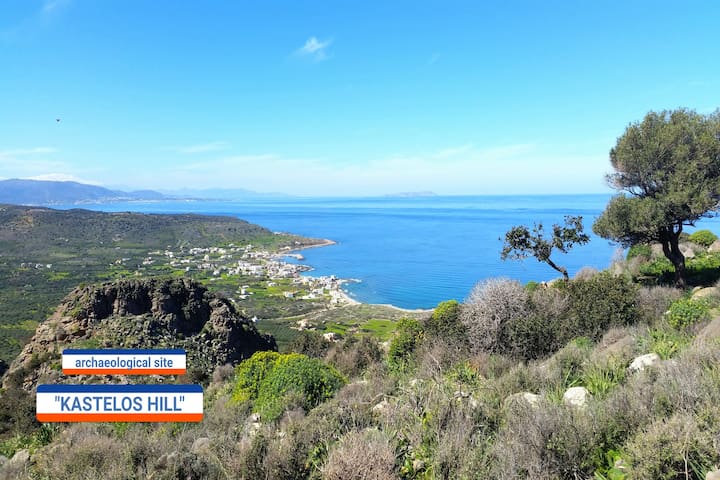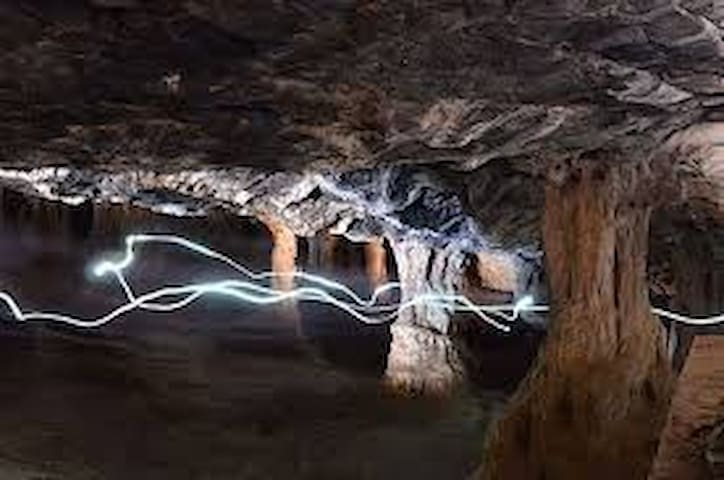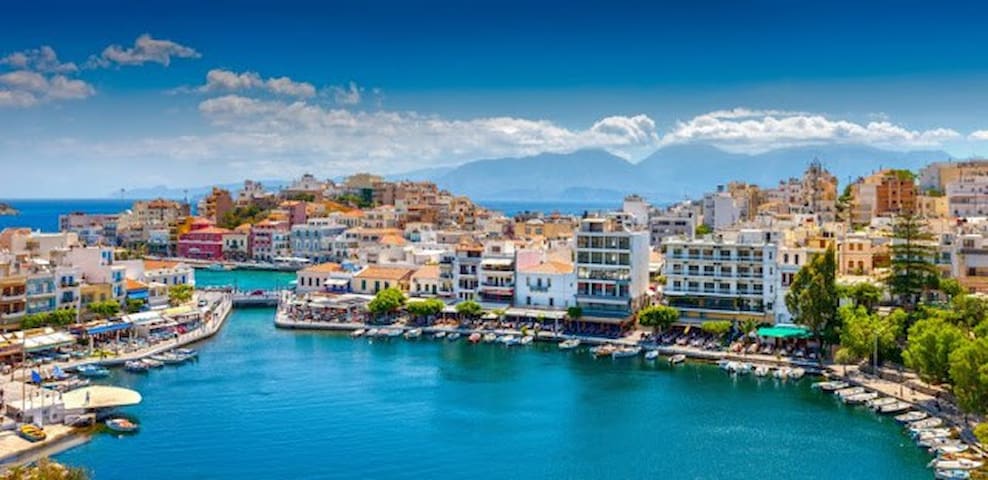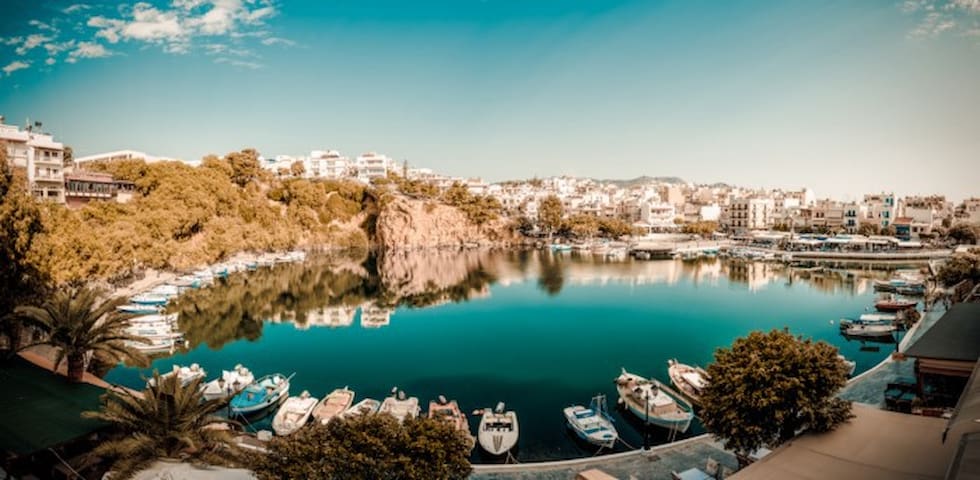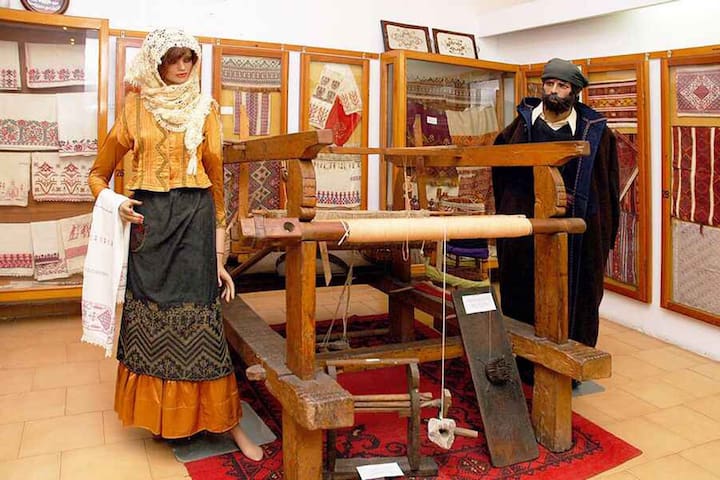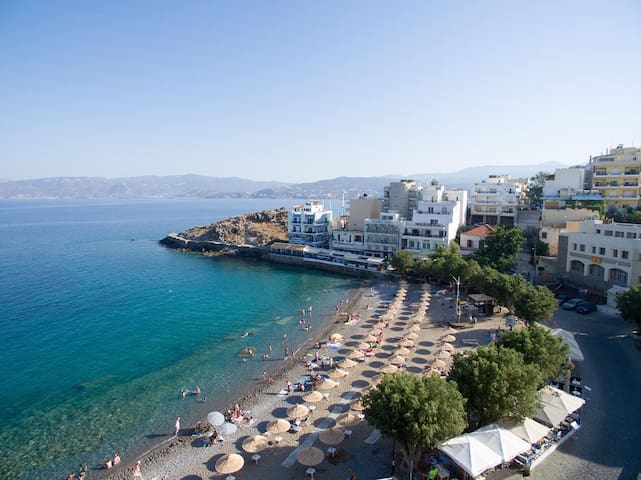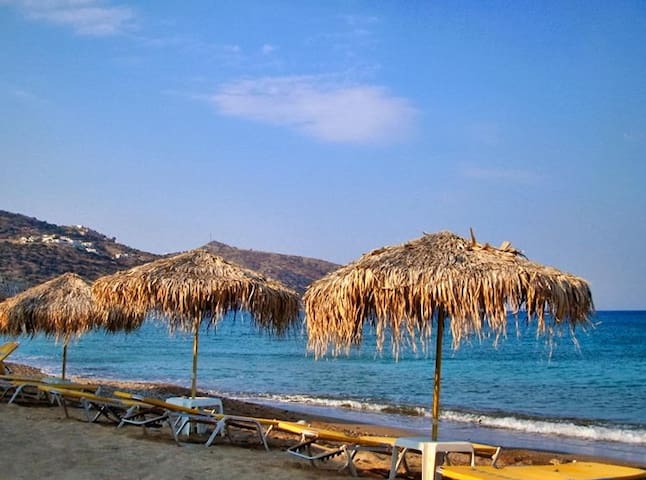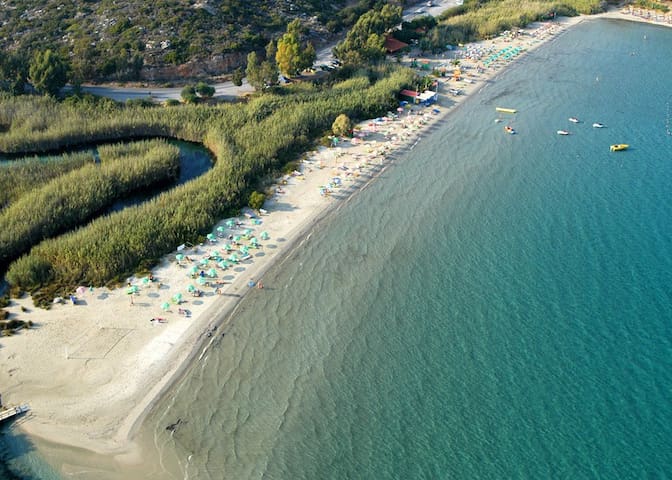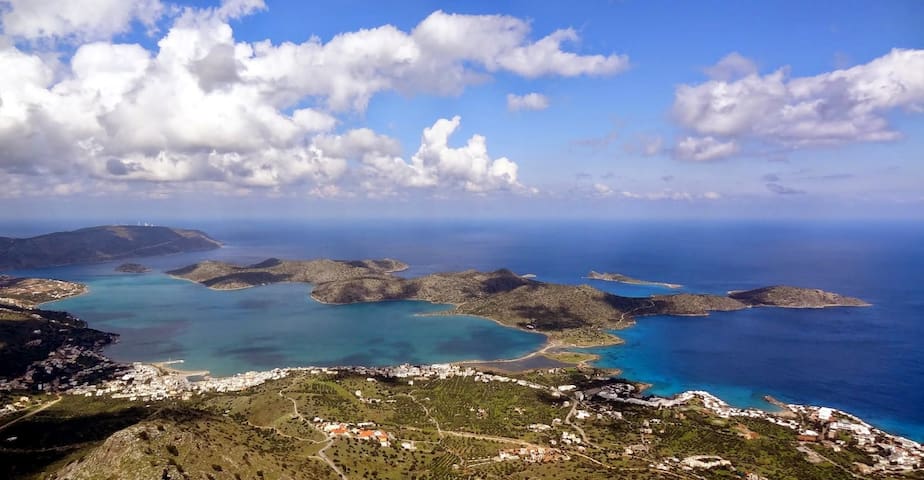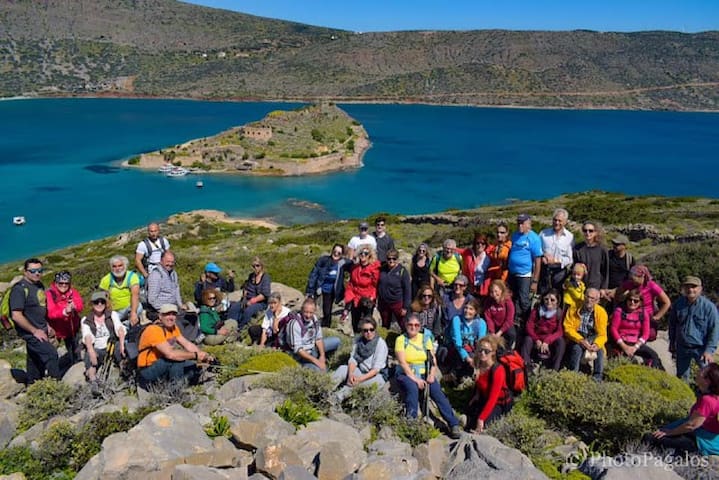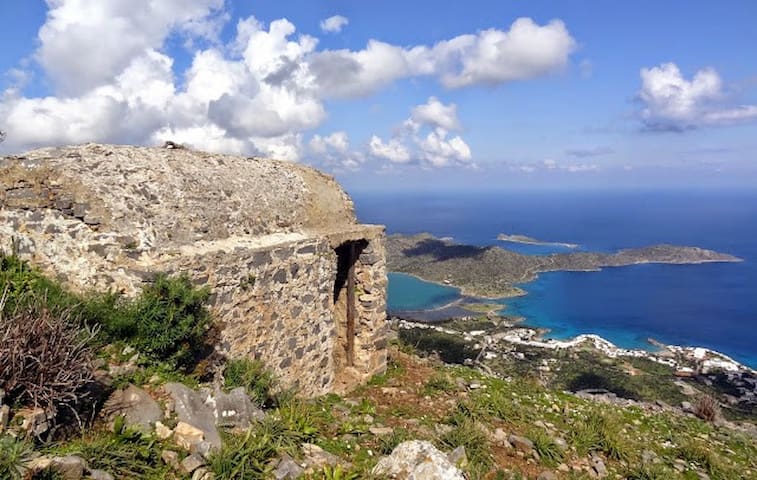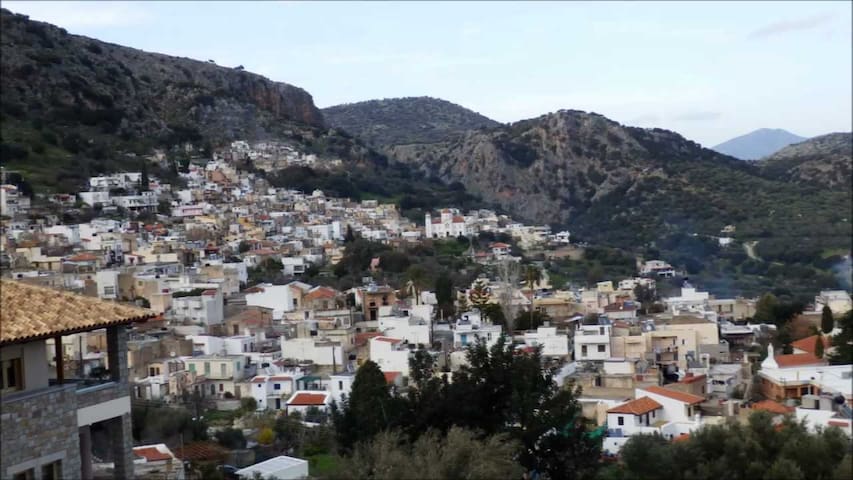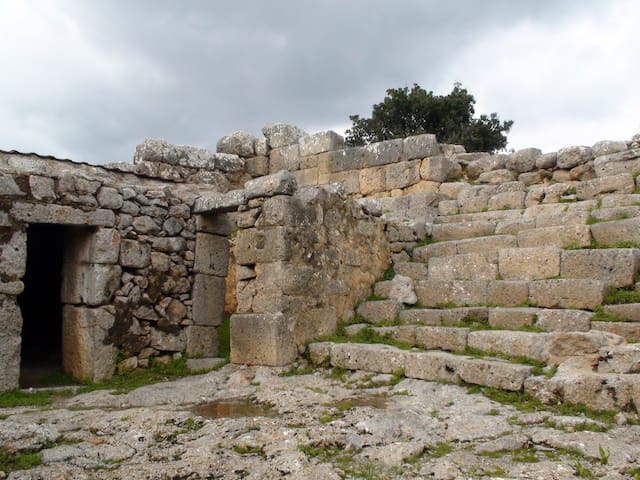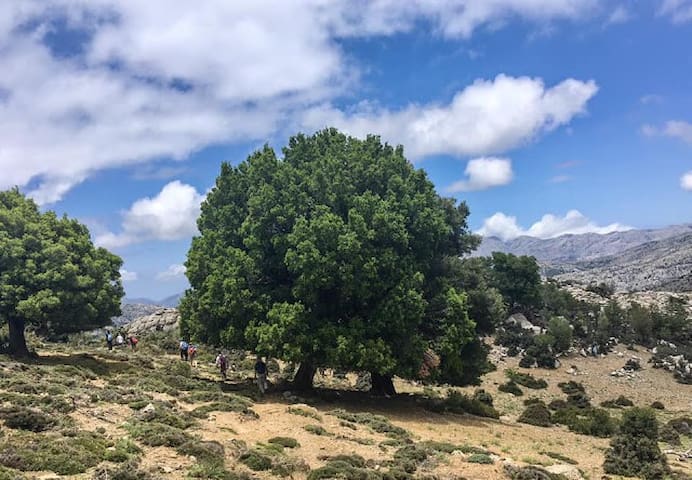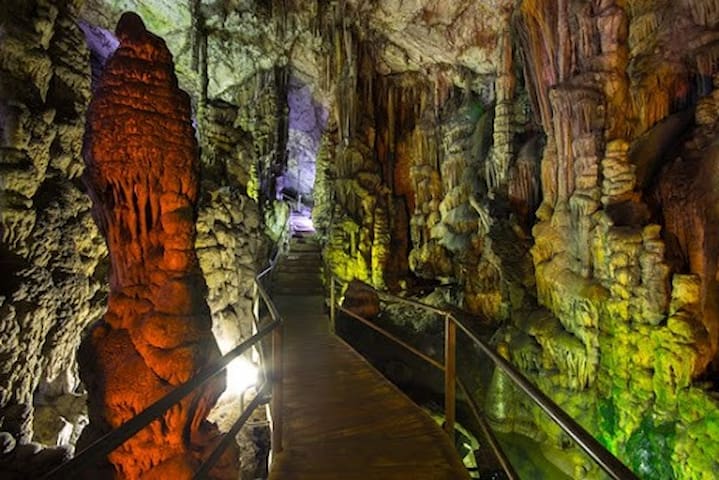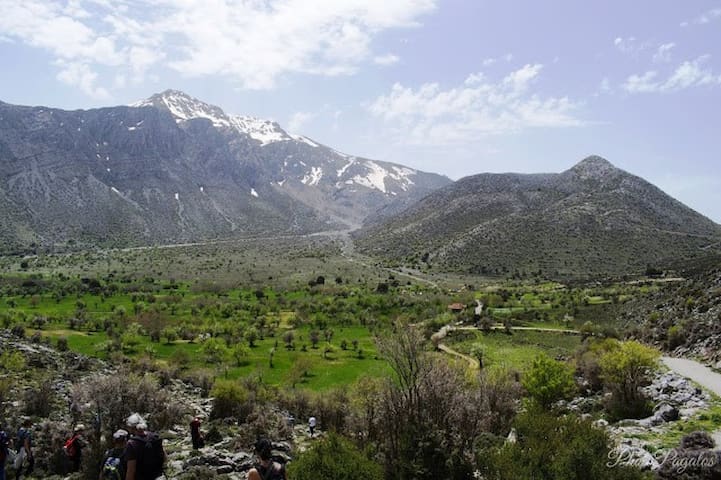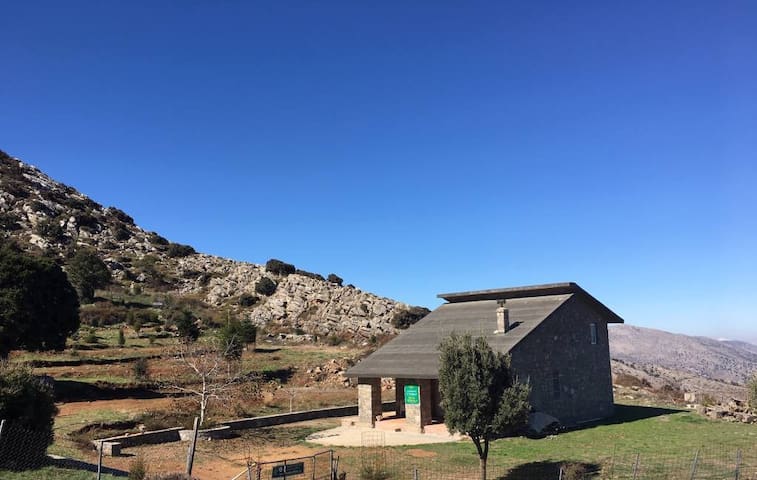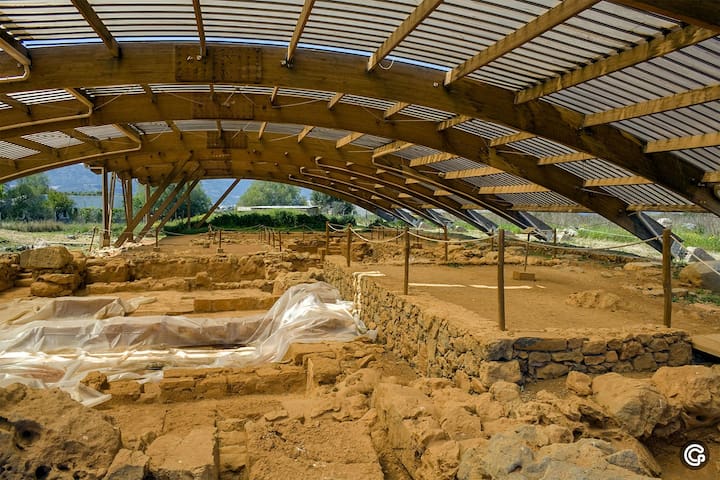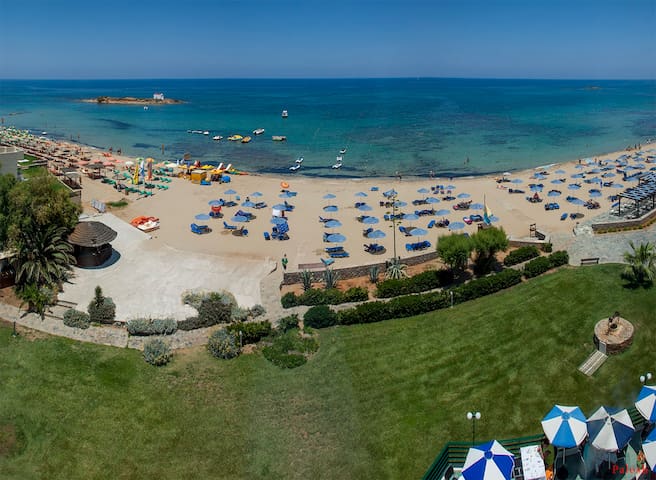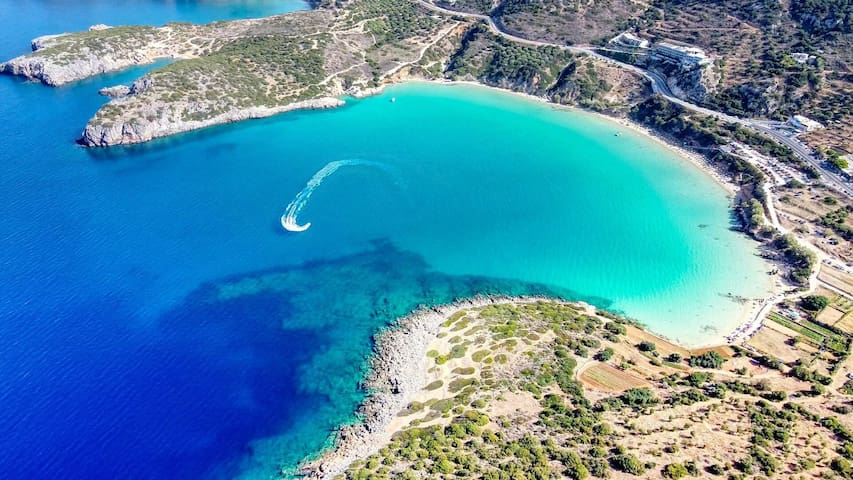City/town information
The picturesque, traditional village of MILATOS is located on the north coast of eastern Crete, in a valley of olive trees. It consists of two parts:the Upper Milatos, a small traditional village with narrow streets and old, stone built and renovated houses, representative of the local architecture and Milatos Beach, built by the sea, with small family hotels, charming beach houses and homely taverns, famous for their fresh fish and traditional cuisine.
Milatos is located next to Malia and Sissi (two of the busiest resorts of Crete) and close (44 km) from the largest city on the island, Heraklion and 39 km from the international airport. It is 26 km from the capital of the prefecture, Agios Nikolaos and next to Elounda which, with its luxurious hotels, is a primary destination of all the famous visitors of Crete.
The village is in the "right distance" from the famous tourist resorts in the area. In that way you can easily visit them and at the same time you can also enjoy the peace and beauty of the sea and the tranquility of nature.
15 íbúar mæla með
Milatos Beach
The picturesque, traditional village of MILATOS is located on the north coast of eastern Crete, in a valley of olive trees. It consists of two parts:the Upper Milatos, a small traditional village with narrow streets and old, stone built and renovated houses, representative of the local architecture and Milatos Beach, built by the sea, with small family hotels, charming beach houses and homely taverns, famous for their fresh fish and traditional cuisine.
Milatos is located next to Malia and Sissi (two of the busiest resorts of Crete) and close (44 km) from the largest city on the island, Heraklion and 39 km from the international airport. It is 26 km from the capital of the prefecture, Agios Nikolaos and next to Elounda which, with its luxurious hotels, is a primary destination of all the famous visitors of Crete.
The village is in the "right distance" from the famous tourist resorts in the area. In that way you can easily visit them and at the same time you can also enjoy the peace and beauty of the sea and the tranquility of nature.
Milatos is a traditional, fishing village famous for its seaside taverns. Locals and visitors from all around come here to taste traditional dishes and fresh fish, by the sea.
Τhe "Cretan diet" and the health of the inhabitants of Crete has become subject of research, discussions, conferences, it has made headlines in newspapers and medical journals. The Cretans feed on products produced by their land, eating plenty of vegetables, fish, snails, legumes and fruits, flavour their food with herbs and plants from the mountains, while almost always accompany their food with wine from the local vineyards. But the main nutrient is olive oil, which for Cretans is the main source of fat.
The frescoes of Knossos and the depictions in vases and jars, state that oil and wine were the essential elements of Minoan people daily life too. Over the centuries, the Cretans maintained these eating habits, making the Cretan diet internationally famous.
Nowadays, traditional taverns throughout the island offer visitors homemade, delicious dishes, based on the principles of the “Cretan diet”.
15 íbúar mæla með
Milatos Beach
Milatos is a traditional, fishing village famous for its seaside taverns. Locals and visitors from all around come here to taste traditional dishes and fresh fish, by the sea.
Τhe "Cretan diet" and the health of the inhabitants of Crete has become subject of research, discussions, conferences, it has made headlines in newspapers and medical journals. The Cretans feed on products produced by their land, eating plenty of vegetables, fish, snails, legumes and fruits, flavour their food with herbs and plants from the mountains, while almost always accompany their food with wine from the local vineyards. But the main nutrient is olive oil, which for Cretans is the main source of fat.
The frescoes of Knossos and the depictions in vases and jars, state that oil and wine were the essential elements of Minoan people daily life too. Over the centuries, the Cretans maintained these eating habits, making the Cretan diet internationally famous.
Nowadays, traditional taverns throughout the island offer visitors homemade, delicious dishes, based on the principles of the “Cretan diet”.
Milatos Beach
"Volia Beach", a few steps away of my holiday home
"Limani Beach", 5min walk from my holiday home. Sandy beach by the port, with always calm waters, ideal for kids.
15 íbúar mæla með
Milatos Beach
"Limani Beach", 5min walk from my holiday home. Sandy beach by the port, with always calm waters, ideal for kids.
"Aspa beach" or the "Secret beach", 300m away from my holiday home. Crystal clear waters and amazing sea-caves.
15 íbúar mæla með
Milatos Beach
"Aspa beach" or the "Secret beach", 300m away from my holiday home. Crystal clear waters and amazing sea-caves.
"Volaki beach", 800m away from my holiday home, in front of a nearby hotel
15 íbúar mæla með
Milatos Beach
"Volaki beach", 800m away from my holiday home, in front of a nearby hotel
Stroll in the narrow alleys of the traditional village of Milatos, with the flower-filled yards, the old stone houses and the locals who still retain the old customs of hospitality.
25 íbúar mæla með
Milatos
Stroll in the narrow alleys of the traditional village of Milatos, with the flower-filled yards, the old stone houses and the locals who still retain the old customs of hospitality.
Discover small picturesque churches, built around the village and enjoy the beauty of nature and stunning views
25 íbúar mæla með
Milatos
Discover small picturesque churches, built around the village and enjoy the beauty of nature and stunning views
Discover the traditional architecture of the area in old houses and other buildings
25 íbúar mæla með
Milatos
Discover the traditional architecture of the area in old houses and other buildings
Milatos village is built near the site of Ancient Militos, which was destroyed in the 3rd century BC. Militos is mentioned by Homer among the seven cities that sent troops to Troy (Iliad B6470). Local mythology states that Milatos was a boy, who was raised in a forest in the area by a female wolf. When he grew up, he killed the tyrant of the city and escaped to the shores of Asia Minor. There he founded the famous colony of Militos in 1500 BC. Militos was the most important Ionian city and is the birthplace of the greatest philosophers (Thalis, Hippodamus, Anaksimandros).
Minoan art objects, as well as Mycenaean tombs and Mycenaean rhythm vessels, have been discovered in the region, indicating a prehistoric past. All those valuable objects are now kept in Iraklion and Agios Nikolaos argeological museums.
In the photo “Kastelos Hill”, that was used centuries ago as a fortress, today overlooks the modern seaside village of Milatos.
25 íbúar mæla með
Milatos
Milatos village is built near the site of Ancient Militos, which was destroyed in the 3rd century BC. Militos is mentioned by Homer among the seven cities that sent troops to Troy (Iliad B6470). Local mythology states that Milatos was a boy, who was raised in a forest in the area by a female wolf. When he grew up, he killed the tyrant of the city and escaped to the shores of Asia Minor. There he founded the famous colony of Militos in 1500 BC. Militos was the most important Ionian city and is the birthplace of the greatest philosophers (Thalis, Hippodamus, Anaksimandros).
Minoan art objects, as well as Mycenaean tombs and Mycenaean rhythm vessels, have been discovered in the region, indicating a prehistoric past. All those valuable objects are now kept in Iraklion and Agios Nikolaos argeological museums.
In the photo “Kastelos Hill”, that was used centuries ago as a fortress, today overlooks the modern seaside village of Milatos.
Αξιοθέατα
Milatos Historic Cave is located 3km northeast of the village, overlooking a plain with olive trees and Aegean Sea. Inside the cave is built a small picturesque chapel.
Path to Milatos Cave
Path to Milatos CaveMilatos Historic Cave is located 3km northeast of the village, overlooking a plain with olive trees and Aegean Sea. Inside the cave is built a small picturesque chapel.
The lovely serene little town of Agios Nikolaos is the cosmopolitan capital of the prefecture
7 íbúar mæla með
Agios Nikolaos
The lovely serene little town of Agios Nikolaos is the cosmopolitan capital of the prefecture
The Lake of Agios Nikolaos, also known as Voulismeni, is located in the centre of the city, being the trademark of it. A walk around the picturesque lake is an unforgettable experience (total perimeter of 500m).
43 íbúar mæla með
Lake Voulismeni
The Lake of Agios Nikolaos, also known as Voulismeni, is located in the centre of the city, being the trademark of it. A walk around the picturesque lake is an unforgettable experience (total perimeter of 500m).
The Folklore Museum of Agios Nikolaos was founded in 1978 and houses objects that give visitor a complete picture of life in the recent past.
Λαογραφικό Μουσείο
41 Kon/nou PaleologouThe Folklore Museum of Agios Nikolaos was founded in 1978 and houses objects that give visitor a complete picture of life in the recent past.
Sandy beach, near the centre of Agios Nikolaos city. Coffee shops and restaurants nearby.
9 íbúar mæla með
Paralia Kitroplatias
Sandy beach, near the centre of Agios Nikolaos city. Coffee shops and restaurants nearby.
Ammoudi beach is located just 1 km north of the center of Agios Nikolaos city, in a deep and well protected bay. It is a small beach with sand and shallow clear waters, with many taverns and coffee shops nearby.
26 íbúar mæla með
Ammoudi Beach
Ηλία ΣωτήρχουAmmoudi beach is located just 1 km north of the center of Agios Nikolaos city, in a deep and well protected bay. It is a small beach with sand and shallow clear waters, with many taverns and coffee shops nearby.
Paralia Chavania
Xavania beach is located 3 km away from Agios Nikolaos city, in a protected bay.
Almyros beach is located 1.5 km from the centre of Agios Nikolaos city and is the most popular beach in the area. It is formed at the exit of the Almyros river, which flows at the southern end of the beach and creates a great wetland with a large supply of brackish water all year round. There are beach bars, taverns and water sports.
7 íbúar mæla með
Paralia Almiros
Almyros beach is located 1.5 km from the centre of Agios Nikolaos city and is the most popular beach in the area. It is formed at the exit of the Almyros river, which flows at the southern end of the beach and creates a great wetland with a large supply of brackish water all year round. There are beach bars, taverns and water sports.
Elounda is located on the northwest side of the large bay of Mirabello. Having one of the most beautiful natural landscapes in Greece, it is a world-renowned tourist resort with luxury hotels for the most expensive tastes.
72 íbúar mæla með
Elounda
Elounda is located on the northwest side of the large bay of Mirabello. Having one of the most beautiful natural landscapes in Greece, it is a world-renowned tourist resort with luxury hotels for the most expensive tastes.
Spinalonga is located in Elounda lagoon, on the north side of Mirabello Bay. It’s a small island with great history: it has been a Venetian fortress, a castle city, a refuge for rebels and a place of exile for lepers. The island was excellently fortified by the Venetians during their presence in Crete. Both from a construction and architectural point of view, as well as from the aesthetics of the whole landscape, the island still retains its unsurpassed beauty.
99 íbúar mæla með
Nisida Spinalonga
Spinalonga is located in Elounda lagoon, on the north side of Mirabello Bay. It’s a small island with great history: it has been a Venetian fortress, a castle city, a refuge for rebels and a place of exile for lepers. The island was excellently fortified by the Venetians during their presence in Crete. Both from a construction and architectural point of view, as well as from the aesthetics of the whole landscape, the island still retains its unsurpassed beauty.
The unknown peninsula of Elounda, joined with the mainland with the very narrow passage of "Poros". Uninhabited, with small churches, abandoned farmhouses, secluded beaches (better known is Kolokytha beach), ancient quarry and stunning views of Elounda and the islet of Spinalonga.
37 íbúar mæla með
Kolokithia Beach
The unknown peninsula of Elounda, joined with the mainland with the very narrow passage of "Poros". Uninhabited, with small churches, abandoned farmhouses, secluded beaches (better known is Kolokytha beach), ancient quarry and stunning views of Elounda and the islet of Spinalonga.
The mountain Oxa, which dominates over the area of Elounda - is ideal for hiking (starting from the village Lenika). We meet the ruins of a fortified town that is believed to be ancient Naxos and enjoy the unique view of the bay.
Ancient Naxos
The mountain Oxa, which dominates over the area of Elounda - is ideal for hiking (starting from the village Lenika). We meet the ruins of a fortified town that is believed to be ancient Naxos and enjoy the unique view of the bay.
Kritsa is a small town of Eastern Crete, built at an altitude of 350m, overlooking a valley of olive trees. It is considered to be an open folklore and historical museum about Crete, as it preserves the traditional Cretan lifestyle. The scenic narrow streets, the blooming yards, the textile shops, the traditional coffee shops, the folklore collections and the Byzantine temples attract dozens of visitors.
42 íbúar mæla með
Kritsa
Kritsa is a small town of Eastern Crete, built at an altitude of 350m, overlooking a valley of olive trees. It is considered to be an open folklore and historical museum about Crete, as it preserves the traditional Cretan lifestyle. The scenic narrow streets, the blooming yards, the textile shops, the traditional coffee shops, the folklore collections and the Byzantine temples attract dozens of visitors.
Kritsa Gorge starts near the picturesque village of Kritsa and ends at the village Tapes. It’s 13km long, reaching a width of only 1.5m in some places and its ‘walls’ are 100m high. It is easily accessible with a few points that need attention, where you have to climb over some big rocks. You can walk all the length of it (6 hours) or only for 1,5 hour and then exit and follow an old path that leads to Kritsa village.
18 íbúar mæla með
Kritsa Gorge
Kritsa Gorge starts near the picturesque village of Kritsa and ends at the village Tapes. It’s 13km long, reaching a width of only 1.5m in some places and its ‘walls’ are 100m high. It is easily accessible with a few points that need attention, where you have to climb over some big rocks. You can walk all the length of it (6 hours) or only for 1,5 hour and then exit and follow an old path that leads to Kritsa village.
Byzantine church (13th-14th century) with rare architecture and magnificent frescoes. It is located between Agios Nikolaos city and the traditional village of Kritsa.
26 íbúar mæla með
Panagias Keras Church
Byzantine church (13th-14th century) with rare architecture and magnificent frescoes. It is located between Agios Nikolaos city and the traditional village of Kritsa.
The ruins of ancient Lato are located 3km north of Kritsa, scattered between two hills at an altitude of 380m. This site has stunning views over the bay of Mirabello. The town existed in the Minoan period, but actually flourished after the Dorian invasion. It was inhabited till the Roman era, when it started to decline. Lato is considered the best preserved town of the classical - Hellenistic period in Crete and one of the most complete in Greece. Here you will see fortifications, market, little theatre, temples, public buildings, cisterns, etc.
9 íbúar mæla með
Latṓ
LatousThe ruins of ancient Lato are located 3km north of Kritsa, scattered between two hills at an altitude of 380m. This site has stunning views over the bay of Mirabello. The town existed in the Minoan period, but actually flourished after the Dorian invasion. It was inhabited till the Roman era, when it started to decline. Lato is considered the best preserved town of the classical - Hellenistic period in Crete and one of the most complete in Greece. Here you will see fortifications, market, little theatre, temples, public buildings, cisterns, etc.
Katharo plateau is located in the Dikti mountain range, at an altitude of 1150 meters, 16 km west of Kritsa. It is a beautiful plateau, with a special microclimate, special flora and fauna, one of the most impressive in Crete. With the highest peaks of the Lassithi mountains (Lazaros 2,085 m and Spathi 2,148 m), dominating, it impresses with images of rare beauty.
It is the ideal area for hiking all year round, with routes of varying degrees of difficulty: on paths in the plateau or ascent to the highest peaks, crossing the gorge of Havgas or hiking to the forest of Selakano or the Lassithi plateau.
Οροπέδιο Καθαρού
Katharo plateau is located in the Dikti mountain range, at an altitude of 1150 meters, 16 km west of Kritsa. It is a beautiful plateau, with a special microclimate, special flora and fauna, one of the most impressive in Crete. With the highest peaks of the Lassithi mountains (Lazaros 2,085 m and Spathi 2,148 m), dominating, it impresses with images of rare beauty.
It is the ideal area for hiking all year round, with routes of varying degrees of difficulty: on paths in the plateau or ascent to the highest peaks, crossing the gorge of Havgas or hiking to the forest of Selakano or the Lassithi plateau.
The gorge of Havgas is located in the mountain range of Dikti and in its riverbed flows a river, which in winter becomes one of the most rapid and impressive rivers of Crete. It has a total length of about 4 km. It is part of the European path E4 and impresses with its wild, unspoiled nature and the impressive 'sara' on its slopes. 'Neraidokolympos', is a magical landscape sculpted by nature and the flow of water and where -according to its name- ... fairies are taking their bath!!!
Neraïdokólympos
The gorge of Havgas is located in the mountain range of Dikti and in its riverbed flows a river, which in winter becomes one of the most rapid and impressive rivers of Crete. It has a total length of about 4 km. It is part of the European path E4 and impresses with its wild, unspoiled nature and the impressive 'sara' on its slopes. 'Neraidokolympos', is a magical landscape sculpted by nature and the flow of water and where -according to its name- ... fairies are taking their bath!!!
The wonderful Lassithi Plateau is located about 25km south of Malia city, in a peaceful and fertile region, at an altitude about 850m. It is surrounded by the wild peaks of Dikti and several smaller plateaus and there are 18 small traditional villages in the area. Every year the plateau is covered by snow which remains in the mountain peaks till mid-spring. It is ideal for cycling and hiking, all year round. There are many different hiking routes of varying degree of difficulty.
59 íbúar mæla með
Lasithi Plateau
The wonderful Lassithi Plateau is located about 25km south of Malia city, in a peaceful and fertile region, at an altitude about 850m. It is surrounded by the wild peaks of Dikti and several smaller plateaus and there are 18 small traditional villages in the area. Every year the plateau is covered by snow which remains in the mountain peaks till mid-spring. It is ideal for cycling and hiking, all year round. There are many different hiking routes of varying degree of difficulty.
The impressive cave of Zeus, the Diktaean Cave, is located in Lassithi Plateau at an altitude of 1025m. The cave, which has an area of 2200 sq.m, is well lit and the paths in it come along a well-designed path of 250m length. It is supposed to be the birth place or God Zeus and later king Minos. Also a version of the famous legend of Europa, tells that when Zeus was transformed to a bull and seduced Europa, he took her in the Cave, where he revealed himself and mated with her.
63 íbúar mæla með
Zeusarhellir
The impressive cave of Zeus, the Diktaean Cave, is located in Lassithi Plateau at an altitude of 1025m. The cave, which has an area of 2200 sq.m, is well lit and the paths in it come along a well-designed path of 250m length. It is supposed to be the birth place or God Zeus and later king Minos. Also a version of the famous legend of Europa, tells that when Zeus was transformed to a bull and seduced Europa, he took her in the Cave, where he revealed himself and mated with her.
The Limnakaro Plateau lies on the northern slopes of Mount Dikti, near the Lassithi Plateau, at an altitude of 1120 m and covers an area of approximately 75 hectares. It is crossed by the European E4 hiking footpath that goes up from the Lasithi Plateau to the spring of Avarsami (1885m) and from there it descends to Selakano. On the way, one can bypass and reach the peaks of Spathi (2148m) and Afendis Christos (2141m).
Limnakaro
The Limnakaro Plateau lies on the northern slopes of Mount Dikti, near the Lassithi Plateau, at an altitude of 1120 m and covers an area of approximately 75 hectares. It is crossed by the European E4 hiking footpath that goes up from the Lasithi Plateau to the spring of Avarsami (1885m) and from there it descends to Selakano. On the way, one can bypass and reach the peaks of Spathi (2148m) and Afendis Christos (2141m).
'LASITHI PLATEAU"
Τhe mountaineering shelter in Strovili, serves the hikers that trek in the wildest part of Dikti. It is accessed via dirt track from Limnakaro plateau and it’s open from May to October.
More info: eoslasithiou@gmail.com @ tel. 6972667591
Katafígion Limakárou EOS Lasithíou
Στροβίλι'LASITHI PLATEAU"
Τhe mountaineering shelter in Strovili, serves the hikers that trek in the wildest part of Dikti. It is accessed via dirt track from Limnakaro plateau and it’s open from May to October.
More info: eoslasithiou@gmail.com @ tel. 6972667591
"FOURNI TRADITIONAL VILLAGE"
The area above the tourist resort of Elounda is called "Pano Mirabello" and offers images from the rural life of Crete a century ago.
Barren, arid, mountainous landscape, with fields covered with stones, olive trees or aromatic shrubs. Many small villages (the largest village is Fourni) with traditionally built stone houses, abandoned or with few inhabitants. Many Byzantine churches, monasteries, windmills, cisterns for collecting rainwater are scattered on the mountain slopes. Ideal area for hiking on old paths or in small gorges.
6 íbúar mæla með
Fourni
"FOURNI TRADITIONAL VILLAGE"
The area above the tourist resort of Elounda is called "Pano Mirabello" and offers images from the rural life of Crete a century ago.
Barren, arid, mountainous landscape, with fields covered with stones, olive trees or aromatic shrubs. Many small villages (the largest village is Fourni) with traditionally built stone houses, abandoned or with few inhabitants. Many Byzantine churches, monasteries, windmills, cisterns for collecting rainwater are scattered on the mountain slopes. Ideal area for hiking on old paths or in small gorges.
"MALIA MINOAN PALACE"
The archaeological site of Malia is located 3km east of Malia, next to the wetland and the beach of Potamos. It was an important Minoan city and housed the third largest Minoan palace, after Knossos and Phaestus. According to mythology, Sarpedon reigned here, who was brother of Minos and son of Zeus and Europa. Sarpedon was expelled by his brother Minos and then took refuge in Lycia in Asia Minor.
41 íbúar mæla með
Malia, Crete
"MALIA MINOAN PALACE"
The archaeological site of Malia is located 3km east of Malia, next to the wetland and the beach of Potamos. It was an important Minoan city and housed the third largest Minoan palace, after Knossos and Phaestus. According to mythology, Sarpedon reigned here, who was brother of Minos and son of Zeus and Europa. Sarpedon was expelled by his brother Minos and then took refuge in Lycia in Asia Minor.
The beach of Malia is a long, wide beach with fine sand and shallow water, 10km away from Milatos village.
Malia Beach
The beach of Malia is a long, wide beach with fine sand and shallow water, 10km away from Milatos village.
Voulisma or Golden Beach is a beautiful beach near Kalo Chorio, with white sand and amazing turquoise waters.
63 íbúar mæla með
Voulisma strönd
Voulisma or Golden Beach is a beautiful beach near Kalo Chorio, with white sand and amazing turquoise waters.
Φαγητό
Open market (fruits, vegetables, souvenirs, gifts etc) every Wednesday in the city of Agios Nikolaos
Λαϊκή αγορά Αγίου Νικολάου
AnonymousOpen market (fruits, vegetables, souvenirs, gifts etc) every Wednesday in the city of Agios Nikolaos
Milatos is a traditional, fishing village famous for its seaside taverns. Locals and visitors from all around come here to taste traditional dishes and fresh fish, by the sea.
Τhe "Cretan diet" and the health of the inhabitants of Crete has become subject of research, discussions, conferences, it has made headlines in newspapers and medical journals. The Cretans feed on products produced by their land, eating plenty of vegetables, fish, snails, legumes and fruits, flavour their food with herbs and plants from the mountains, while almost always accompany their food with wine from the local vineyards. But the main nutrient is olive oil, which for Cretans is the main source of fat.
The frescoes of Knossos and the depictions in vases and jars, state that oil and wine were the essential elements of Minoan people daily life too. Over the centuries, the Cretans maintained these eating habits, making the Cretan diet internationally famous.
Nowadays, traditional taverns throughout the island offer visitors homemade, delicious dishes, based on the principles of the “Cretan diet”.
15 íbúar mæla með
Milatos Beach
Milatos is a traditional, fishing village famous for its seaside taverns. Locals and visitors from all around come here to taste traditional dishes and fresh fish, by the sea.
Τhe "Cretan diet" and the health of the inhabitants of Crete has become subject of research, discussions, conferences, it has made headlines in newspapers and medical journals. The Cretans feed on products produced by their land, eating plenty of vegetables, fish, snails, legumes and fruits, flavour their food with herbs and plants from the mountains, while almost always accompany their food with wine from the local vineyards. But the main nutrient is olive oil, which for Cretans is the main source of fat.
The frescoes of Knossos and the depictions in vases and jars, state that oil and wine were the essential elements of Minoan people daily life too. Over the centuries, the Cretans maintained these eating habits, making the Cretan diet internationally famous.
Nowadays, traditional taverns throughout the island offer visitors homemade, delicious dishes, based on the principles of the “Cretan diet”.

